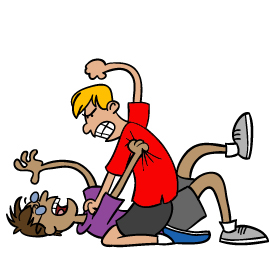 Physical bullying
Physical bullying
Physical bullying includes hitting, kicking, tripping, pinching and pushing or damaging property. Physical bullying causes both short term and long term damage.
 Verbal bullying
Verbal bullying
Verbal bullying includes name calling, insults, teasing, intimidation, homophobic or racist remarks, or verbal abuse. While verbal bullying can start off harmless, it can escalate to levels which start affecting the individual target. Keep reading in this section for techniques to deal with verbal bullying.
 Social bullying
Social bullying
Social bullying, sometimes referred to as covert bullying, is often harder to recognise and can be carried out behind the bullied person’s back. It is designed to harm someone’s social reputation and/or cause humiliation. Social bullying includes:
- lying and spreading rumours
- negative facial or physical gestures, menacing or contemptuous looks
- playing nasty jokes to embarrass and humiliate
- mimicking unkindly
- encouraging others to socially exclude someone
- damaging someone’s social reputation or social acceptance.
 Cyber bullying
Cyber bullying
Cyber bullying can be overt or covert bullying behaviours using digital technologies, including hardware such as computers and smartphones, and software such as social media, instant messaging, texts, websites and other online platforms.
Cyber bullying can happen at any time. It can be in public or in private and sometimes only known to the target and the person bullying. Cyber bullying can include:
- Abusive or hurtful texts emails or posts, images or videos
- Deliberately excluding others online
- Nasty gossip or rumours
- Imitating others online or using their log-in
(Types Of Bullying | National Centre Against Bullying. (2017). Ncab.org.au. Retrieved from: https://www.ncab.org.au/bullying-advice/bullying-for-parents/types-of-bullying/).


 Physical bullying
Physical bullying Verbal bullying
Verbal bullying Social bullying
Social bullying Cyber bullying
Cyber bullying